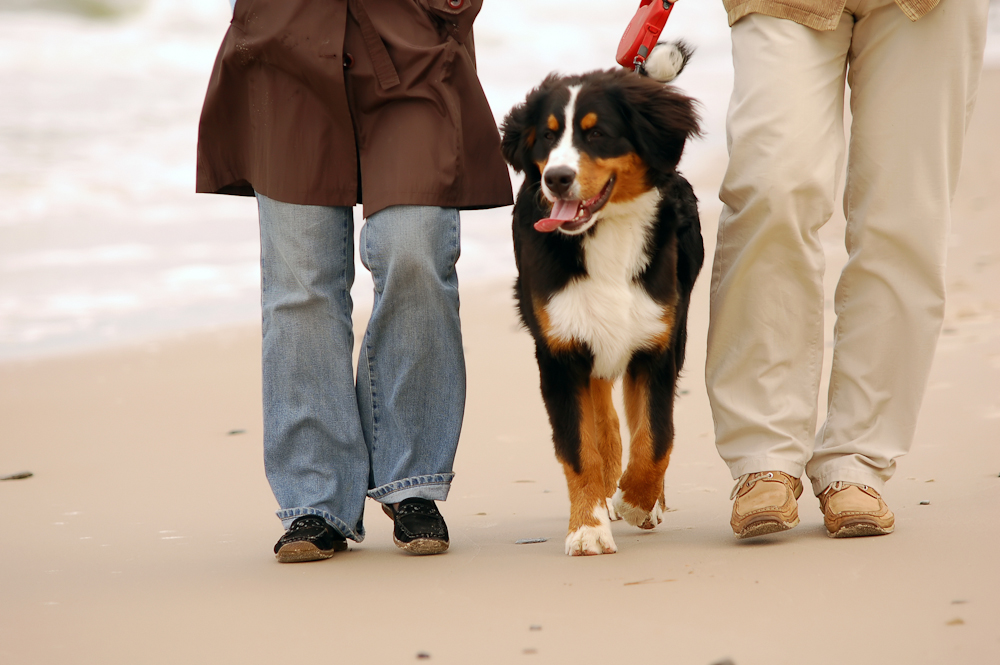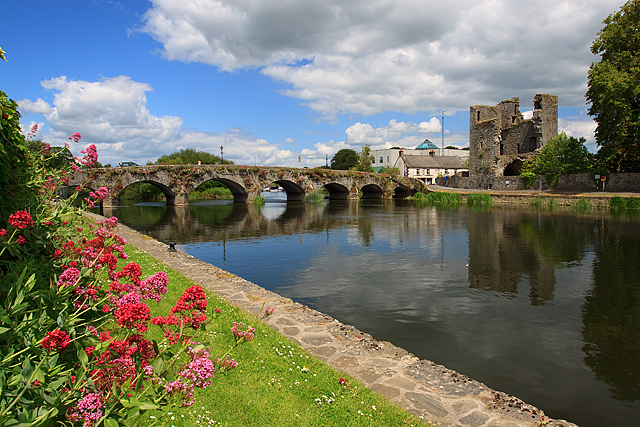What are the rules for bringing my dog into Ireland?
What are the rules for bringing pets into Ireland from member EU states (except the UK)?
If you want to import a dog or cat into Ireland from any EU member state, except for the UK, the pet must have an EU Pet Passport, (this document is the same throughout the EU). The Passport certifies that:
- The pet is travelling from an eligible country.
- The pet is identified by an implanted microchip.
- The pet has been successfully blood-tested for rabies anti-bodies at least six months before entry.
- The pet has been vaccinated against rabies.
- The pet has been treated for tick and tapeworm. The pet must be treated between 24 and 48 hours before travel and the time and date of treatment must be entered on the passport.
In addition, the pet must travel on an approved carrier on an approved route with its owner or with a person acting on behalf of the owner (unaccompanied pets cannot travel to Ireland under the EU Pet Passport System).
Under the EU Pet Passport System it is possible to bring dogs and cats into Ireland from a range of countries deemed low risk for rabies without the need for quarantine, provided that the following conditions are met:
- you are traveling directly from an eligible country
- you are traveling with an approved carrier
- your pet is over three months old
- your pet will be accompanied
- your pet has been micro-chipped
- your pet has been vaccinated against rabies
- your pet has been successfully blood-tested
- you have a passport or veterinary certificate completed by veterinarian certifying identification, vaccination and blood-test
- at least six months has expired since a successful blood-test
- your pet has been only in an eligible country during this six months
- you pet has been treated for tick and tapeworm between 24 and 48 hours before check-in at ferry terminal or airport
More details can be found on The Irish Department of Agriculture, Fisheries and Food website: Travel to Ireland with a pet and a Pet Passport (Except UK)
What are the rules for bringing pets into Ireland from qualifying non-EU countries?
If you want to import a dog or cat into Ireland from a qualifying non-EU country, the pet animal must undergo the following in this order:
- Be microchipped (this must be done before anything else).
- Be vaccinated for rabies (may be done on the same day as microchipping).
- Be bloodtested after rabies vaccination and microchipping at least six months before entry (the pet must have a result greater than 0.5 IU/ml).
- Be treated for tick and tapeworm between 24 and 48 hours before departure.
- Have a Veterinary Certificate (passport) issued or endorsed by the competent authority in the country of origin.
- Be accompanied by the owner (or person acting on their behalf) on an approved carrier into Ireland.
What are the rules for bringing pets into Ireland from all other non-eligible countries?
If you want to import a dog or cat into Ireland from a country other than one eligible for the EU Pet Passport System, you must have an import licence from the Department of Agriculture, Fisheries and Food. The pet will be required to spend six months in the public quarantine in Ireland.
There is only one approved public quarantine premises: Lissenhall Quarantine Kennels and Catteries, Lissenhall, Swords, Co Dublin, Tel: +353 1 8900375, Fax: +353 1 8409338. Animals must spend their six-month quarantine here.
The animal must be transported by air to Ireland and land at Dublin, Cork or Shannon airports and be brought on by air to Dublin if necessary. Transport from the airport to the quarantine must be undertaken by the sole authorised carrying agent: Kelly Couriers, 30 Selskar Avenue, Skerries, Co. Dublin. Telephone: +353-1-8490807 Fax: +353-1-8029801.
This arrangement is to be undertaken by the owner.
All costs (quarantine, veterinary fees, transport etc.) must be met by the owner. Arrangements for quarantine and transport must be in place before an import licence is granted. It's important to remember that the animal may not travel without an import licence.
What should I do if I find a dog?
If you find a dog then the first thing to do is to look for a collar. If the dog has a collar next check for an identity tag.
The tag could be plastic or metal and should have a phone number on it. If the dog has a collar but no tag try removing the collar and check under it for a phone number.
If you cannot see any visable identity tags on the dog then bring it to the vet or animal shelter. There the staff can scan the dog for a microchip that is located under the skin. If a microchip is found it will have the contact details of the owner.
If there is no microchip then contact local radio and have them make an announcement that a dog was found and tell them the general area and some vague details.
If it is possible bring the dog home with you or if not bring the dog to the local animal shelter or rescue centre, there will be no charge to you. Please do not just release the dog again.
Contact Garda stations and let them know that you have found a dog. If you can put up a poster and continue to call in person to the station every day.
You should contact other Garda stations too as contact between stations can be limited at the best of times.
Contact dog wardens as the person missing the dog may have been in contact with them already.
You can post details on various websites like www.lostandfoundpets.ie, www.lostandfound.ie orwww.pets.ie.
These websites will have sections for both lost and found dogs. Enter the details of the dog you have found and then check the lost section for dogs that are missing.
If you see details of a dog that is missing from far away remember this may still be the dog you have found. Reply to the person that posted the lost dog and let them ask questions of you e.g the colour of the dog etc.
What should I do if I lose my dog?
Dogs go missing all over Ireland every day for one reason or another. It could be something simple like a child leaving a door open or something bad like your dog being stolen from your back garden
Whatever the reason it is important that your search starts straight away. The first thing to do is to contact the local radio station and have them make an announcement as soon as possible.
Make up flyers and posters with a recent photo of your pet, it is no good having a photo of your Saint Bernard as a puppy when he is now 3 years old. You should put to mobile phone numbers and never a landline. Maybe mention that a reward is offered but do not state how much.
Call to the houses in the neighbourhood and ask them to spread the word too. Ask homeowners to check out buildings and gardens. Go to the places that you would usually walk your dog as the dog may have wandered off and familiar smells may have led him back there.
Make an appeal to people you know by using social websites like twitter and facebook. Many peole in local areas are connected through these sites and someone may know someone who found a dog in the area.
Contact Garda stations and let them know that your dog is missing. if you can put up a poster and continue to call in person to the station every day. You should contact other Garda stations too as contact between stations can be limited at the best of times.
Contact vets and animal shelters as someone may have found a dog and brought them there. If the dog is microchipped then the vet or shelter can read these chips. If the vet or shelter cannot find identification on your dog then they may have contacted the dog warden.
Dog wardens work for local councils and they pick up stray dogs in the council area. These dogs are taken to the local dog pound and if the dog is not claimed after 5 days it will be put to sleep. Be sure to contact the warden yourself and explain your dog is missing and if he finds the dog he can contact you. Contact dog wardens in other counties too as your dog may have ventured a distance since getting away.
You can post details on various websites like www.lostandfoundpets.ie, www.lostandfound.ie orwww.pets.ie. These sites allow you to upload photos and details of your pet which others can view instantly.
Are there any restrictions on dog breeds in Ireland?
Are there any restrictions on dog breeds in Ireland?
Yes, the Irish government has placed a number of restrictions on certain breeds of dogs. You can read more here.
Do I need to license my dog?
By law all dogs in Ireland over the age of 4 months must have a licence.
Dog licences are issued by post offices or local authorities. The revenue from them finances the operation of dog control services.
In order to obtain a dog licence, you must be over 16 years of age.
All dogs over 4 months of age must have a licence. Puppies under 4 months who are still with their mothers do not need licences but once they leave their mothers they must have a licence.
Your dog must be accompanied by and be under your effective control or the control of another responsible person if it is outside your home or premises or the home or premises of the person in charge of it.
A dog warden can ask you to produce evidence of your dog licence and failure to do so can result in an on the spot fine. Failure to pay this fine within a specified period can result in prosecution by the local authority.
If you arer found to have a dog with no dog licence then you will receive an on the spot fine of €30 payable to your local authority. If this fine is not paid it lead to prosecution in the District Court with a maximum fine of €1904.61 and/or 3 months imprisonment.
An individual dog licence costs €12.70 and is valid for one year.
Dog Friendly Beaches
The beaches in Ireland are great places to spend time with your dog. In many counties, dogs are welcome, as long as they are kept on a lead and you clean up after them. But you do need to be aware of rules when taking your dog onto a beach, as they vary from county to county.
Blue Flag Beach Rules Concerning Dogs
National laws concerning dogs are strictly enforced on all Blue Flag beaches. Their access and activities must under all circumstances be controlled. Dogs must be kept on a lead or under close control on all adjoining or abutting areas throughout the bathing season. Dog-owners are responsible for cleaning up after their dog. Dog refuse bins are generally provided. It is recommended that an area be provided for the public to exercise dogs and this should be clearly delineated. In areas with local byelaws or national legislation prohibiting the entrance of dogs on a Blue Flag beach in certain periods, this legislation must be followed.
Dog Friendly Beaches
Here are some dog friendly beaches to get you started.
Greystones Beach, Greystones, Co. Wicklow
Baxter at the DSPCA Doggy Day Out
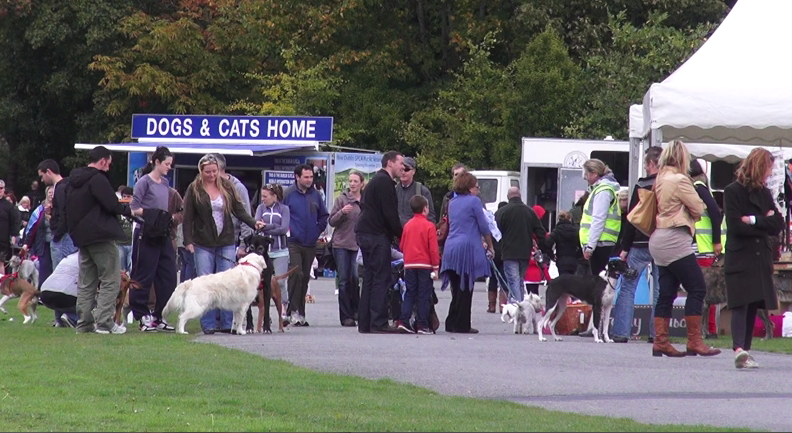
Marlay Park today.
There were plenty of events to choose from, such as ‘Scrufts’ the all-inclusive dog competition, to a demonstration from Dog Sled Ireland, from Dog Training Sessions with ‘King of Paws’ Alex Pitrelli, to doggy speed dating; this canine carnival had something for everyone. But the best part was getting together for a group photo of all the dogs and their owners.
The Dublin SPCA is Ireland’s oldest animal welfare organisation and every year it rescues, re-homes and cares for thousands of dogs through its centre in Rathfarnham and its mobile veterinary clinics. The DSPCA relies on charitable donations to keep its service in operation.
To read more about the DSPCA, please click here.
'Rules' of the Way: Walking Your Dog in the Wicklow Mountains
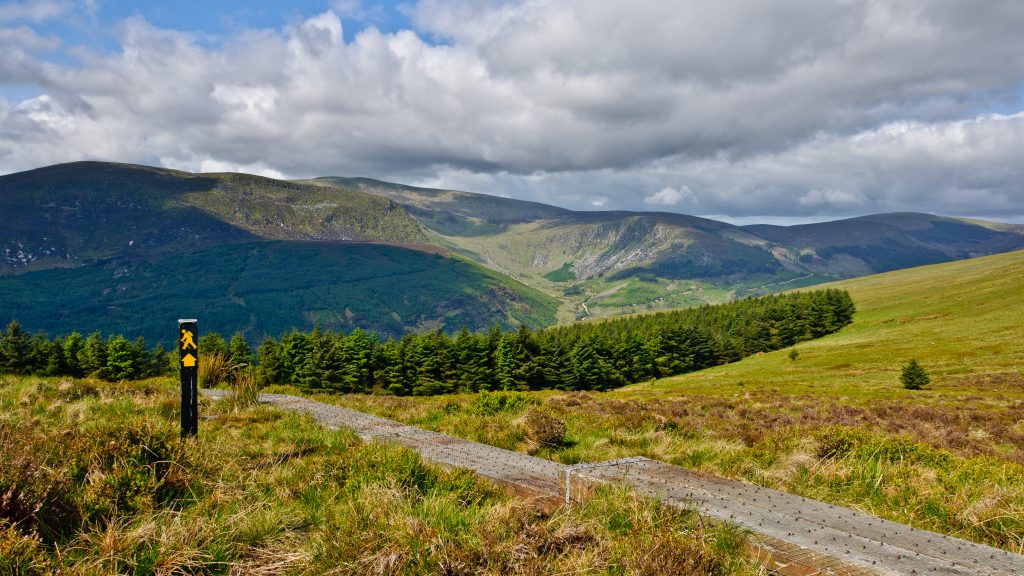
With over 20,000 hectares of spectacular upland scenery, The Wicklow Mountains National Park offers walkers a real sense of being in the wilderness. The National Park offers an open access policy allowing visitors to explore freely on foot. Which means it's important for dog owners to act responsibly.
If you plan on taking your dog with you, it's important to bear in mind the following four points when visiting the National Park.
- Is Your Dog Under Control?
Always carry a lead when walking with your dog in the National Park. The National Park is full of deer. Few dogs can resist the temptation to chase animals. Never let your dog out of your sight. Stressed farm animals can die. Be warned: Farmers in Ireland are entitled to shoot dogs that worry their livestock.
- Not Everyone Likes Dogs
Some people may be scared of dogs, especially children. Even the friendliest dog may worry small children. Few people appreciate being sniffed, jumped on or sprayed by water when a dog shakes itself. Be prepared to slip a lead on your dog when people approach.
- Beware of Cliffs!
Dogs are not equipped for steep ground. Unlike the mountain goats you may see in the National Park, dogs are not adept at leaping from rock to rock. Don't let your dog chase deer or goat. It could lead your dog to a cliff fall. Be warned: Mountain Rescue only rescue humans, not dogs!
- Pick Up After Your Dog
Our dog's are fed high quality food, which means the nutrients they bring can be detrimental to the habitat of the National Park. A deer eats heather, poops heather, feeds heather, etc. Visiting dogs can introduce pathogens in their faeces that can affect wildlife. Always carry a plastic bag or poop scoop and pick up after your dog.
You can read more about taking your dog for a walk in the Wicklow Mountains National Park here.
Useful links:
Overview of the Wicklow Way Trail
The Barrow Way, Co. Carlow
Rising in the Slieve Bloom Mountains in the southern midlands, and joining the rivers Nore and Suir, before flowing into the Celtic Sea at Waterford Harbour, the River Barrow lays claim to being the second longest river in Ireland.
First made navigable in the eighteenth century, the Barrow stretches for 114km from the canal hamlet of Lowtown in County Kildare to the beautiful monastic site and village of St Mullins in south County Carlow.
With its peaceful route through a quiet landscape, a constantly expanding river for company, and grassy towpaths, tracks and quiet roads, the Barrow Way is perhaps one of the most peaceful walks in Ireland.
Type of Walk: National Waymarked Trail
Level of Difficulty: An easy walk
Length: 100km
Start Grid Point: N 790 250
Finish Grid Point: S 728 378
Ordnance Survey Map: OSI Discovery Series Sheets 49, 55, 61 and 68
You can read more about walking The Barrow Way at Irishtrails.ie.
'Walkers Welcome' in Coillte's Forest Trails
Not all land owners welcome recreation users onto their land. This can be for a variety of reasons, privacy, safety, conservation, protection of life stock or crops etc. However Coillte welcomes responsible users who practice 'Leave No Trace' and allows permissive access for walkers to its estate of over 1,000,000 acres.
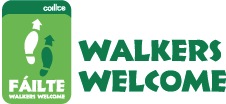 Forests are a great place to walk with your dog. Many of Coillte's forest lands are in some of Ireland's most beautiful locations. To help you with knowing where access is allowed to walkers, Coillte are posting "Walkers Welcome" signs at the entrances to their forests, so you are free to go in when you see this sign.
Forests are a great place to walk with your dog. Many of Coillte's forest lands are in some of Ireland's most beautiful locations. To help you with knowing where access is allowed to walkers, Coillte are posting "Walkers Welcome" signs at the entrances to their forests, so you are free to go in when you see this sign.
Over the coming months, we're going to be featuring some of Coiltte's forest walks here on PetFriendlyIreland.

